
Guinea

Denominazione ufficiale: Repubblica di Guinea
Official name: Republic of Guinea
Nome nella lingua originale: République de Guinée
Superficie: 245.857 km²
Popolazione: 10.211.437 ab. (2008)
Appartenenza: Stato sovrano
Tipo di governo: Giunta militare
Capitale: Conakry
Moneta: Franco guineano
Lingue ufficiali: Francese
Nascita: Indipendenza dalla Francia, 2 ottobre 1958
Area: Africa
Fuso orario: UTC +0
Prima emissione: 1959
Ultima emissione: Attuale
Per saperne di più: http://it.wikipedia.org/wiki/Guinea
Annotazioni: Ingresso nell'ONU 8 ottobre, 1962.
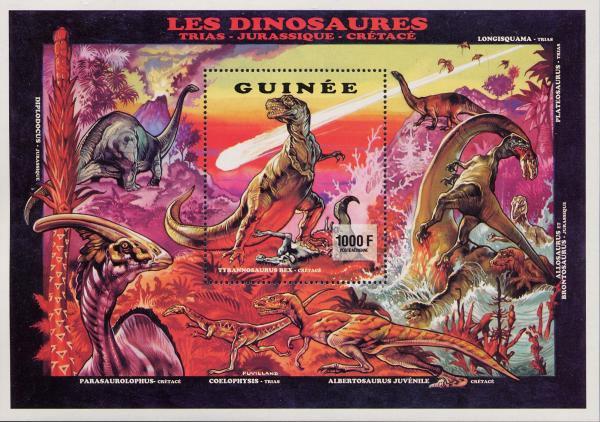
Soggetto: Cretaceous impact Anno: 1993 Notizie: In 1993 the Republic of Guinea issued an airmail souvenir sheet showing several dinosaurs against the background of a volcano and an incoming cosmic impactor. This may represent the giant impact at the end of the Cretaceous, which may have caused the extinction of the dinosaurs. The dinosaurs pictured on the sheet include Diplodocus, Tyrannosaurus Rex, Longisquama, Plateosaurus, Allosaurus, Brontosaurus, a juvenile Albertosaurus, Coelophysis, and Parasauralophus. |
|---|
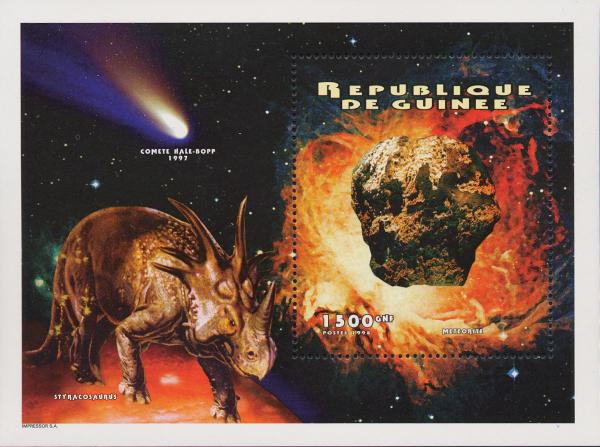
Soggetto: comet Hale-Bopp Anno: 1998 Notizie: In 1998 the Republic of Guinea may have issued a miniature sheet showing comet Hale-Bopp which graced the night skies in 1997, a Styracosaurus, and a meteorite. Styracosaurus, whose name means "spiked reptile", was a ceratopsian dinosaur of the late Cretaceous period. Styracosaurus possessed a large nose horn and notable spikes on its frill. |
|---|
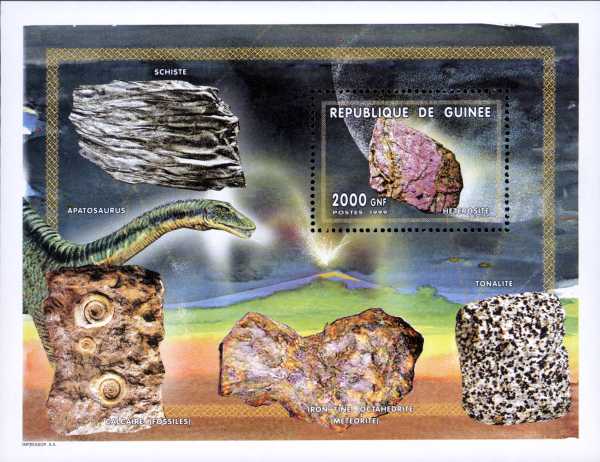
Soggetto: five rock specimens Anno: 1999 Notizie: In 1999 the Republic of Guinea may have issued a miniature sheet showing an apatosaurus and five rock specimens against a volcanic background. The rock specimen in the middle of the bottom row is an iron meteorite, a fine octahedrite. Perhaps the best known examples of fine octahedrites are specimens from the Gibeon meteorite shower which fell in prehistory in Namibia. The other four rock specimens depicted are crystalline shale (upper left), limestone containing fossils (lower left), tonalite (lower right), and heterosite (upper right). |
|---|

Soggetto: the Gao meteorite Anno: 2003 Notizie: The second stamp depicts a specimen of the Gao meteorite, also known as Gao-Guenie. This meteorite exploded in the atmosphere and fell about 60 kilometers to the north of the town of Leo in Burkino Faso, Africa on March 5, 1960 at about 17:00 hours. Stones fell in a triangular area about 13 kilometers on each side. Some stones penetrated the roofs of village huts, but no one was seriously hurt. Estimates of the total weight of the specimens so far found range from 100 kilograms to 500 kilograms. Gao is classified as an ordinary olivine-bronzite chondrite. Many specimens display a beautiful dark brown fusion crust, evidence of the intense heating and melting of the outer layer of the meteorite as it fell. |
|---|
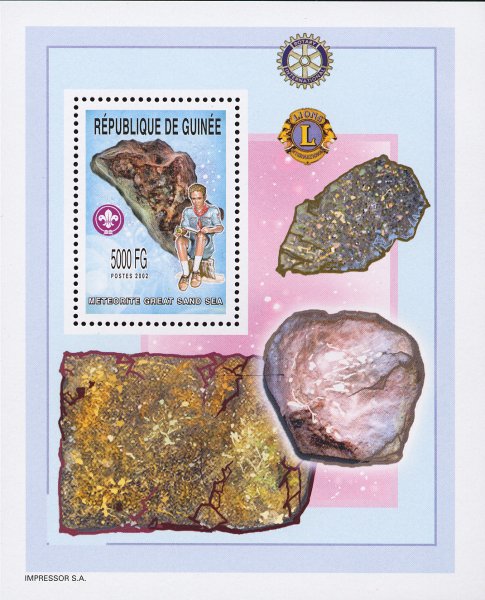
Soggetto: the Great Sand Sea meteorites Anno: 2003 Notizie: The third stamp depicts a meteorite from the Great Sand Sea, a name given to the Sahara desert region of Libya and Egypt. Many meteorites have been found in the deserts of North Africa in recent years, and the Great Sand Sea is no exception. In addition to meteorites, the Great Sand Sea is also the source of the mysterious Libyan Desert Glass, a type of tektite or impact glass perhaps produced by a powerful meteoritic airburst over the desert. This beautiful material resembles chalcedony in appearance and was used to create jewelry in ancient Egypt. For example, Pharoah Tutankhamun's breast plate features a centrally placed scarab carved from translucent yellow Libyan Desert Glass. |
|---|
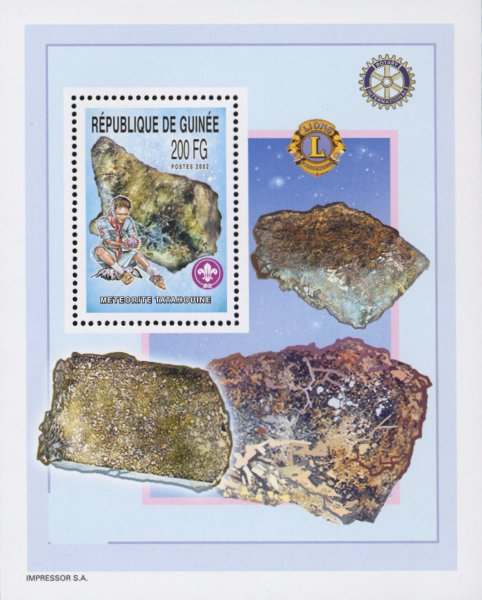
Soggetto: the Tatahouine meteorite Anno: 2003 Notizie: The first stamp depicts a specimen of the Tatahouine meteorite. This meteorite exploded in the atmosphere about two miles northeast of the Tunisian village of Tatahouine on June 27, 1931. Hundreds of fragments ranging in size from about 2 kilograms down to 1 gram landed over an area of about one square kilometer. About 12Tatahouine is classified as a calcium poor diogenite, a type of achondrite meteorite believed to have originated on the asteroid Vesta. Specimens of Tatahouine are usually light olive-green in color and display a green crystalline structure crisscrossed by small black veins. These characteristics are well presented in the stamp image. |
|---|